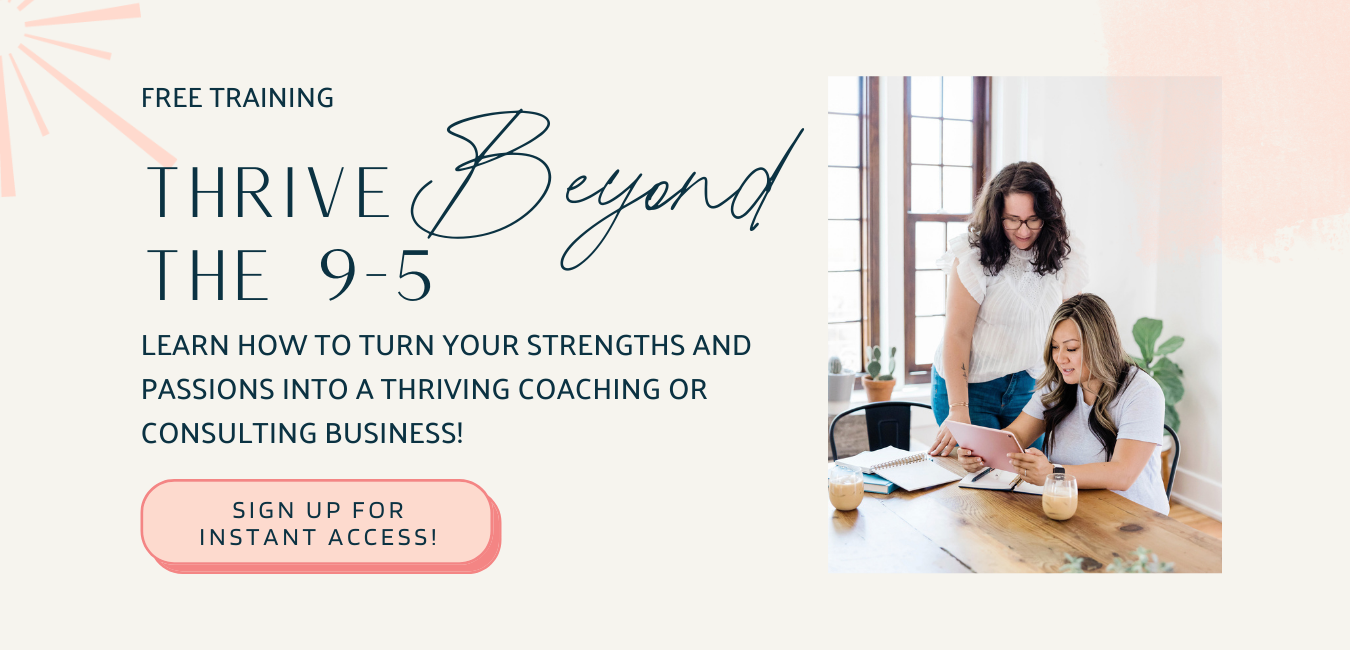How to Really Own Your Strengths
Are you owning or renting your strengths?
That might seem like an odd question to ask, but many of us don’t realize our true potential because we have no idea what our strengths are.
And, even if you do know your strengths, you may not always own them.
You don’t want to sound braggy or arrogant when talking about yourself, so you downplay your strengths and diminish your accomplishments.
Instead of taking responsibility for their own insecurity, people may criticize or judge you for your strengths. If that happens, you might think your greatest strengths are actually a weakness or something you should hide.
It’s time to really own your strengths!
You have a unique blueprint of strengths that make you who you are. In fact, according to Gallup, the chances of someone else having the same strengths as you in the same order is 1 in 33 million.
So you are literally one in a million!
When you own your strengths and continue to build them, you can achieve your biggest goals and dreams.
Here’s how to really own your strengths:
1. Identify your strengths
Your strengths are the skills and experiences that strengthen you, the ones that keep you energized, and the ones that feel effortless to you. When you use your strengths every day, you’re more likely to feel productive, engaged and satisfied.
According to Gallup, people who use their strengths every day are six times more likely to be engaged on the job. And that goes for using your strengths in your own business, too.
When you create a business that allows you to use your strengths every day, you’ll be excited to get up for work and bring your best every single day to support your clients and customers.
Instead of trying to “fix” your weaknesses or focusing on the tasks and skills that drain you, focus on building and honing your strengths. This way, you can identify the parts of your job or business that allow you to use your strengths each day, and the parts that don’t.
To identify your strengths, start with an assessment like Gallup’s StrengthsFinder, or a free test like HIGH5.
You can also use my free Feminine Leadership Styles Quiz to learn more about your unique leadership style and how you can apply that to your career or business, no matter what your role is now.
2. Verify your strengths
When you take the assessments, you’ll receive a report with your Top 5 Themes (or strengths). You can print out your report, read the descriptions to better understand each of the themes, highlight the words or phrases that sound most like you, and cross out the words and phrases that sound least like you.
If you prefer to keep things digital, then open a fresh document and simply copy and paste the words or phrases that sound most like you into that document. Don’t worry about the phrases that sound least like you. This way, you’ll have a document that really reflects who you are.
Take some time to review and really understand your results from your report. You can even journal about your results using the following prompts:
What was your initial reaction to your results?
What surprised you the most?
Were you expecting to see a different strength at the top?
What did you discover about yourself?
Then, share your report with someone close to you. It could be your partner, children, mentor, coworker or friend. If you can, choose a few people from different areas of your life so you can have many perspectives.
Ask them to read your report, then ask them the following questions:
Which parts of the report really describe me?
What surprised you?
Which of these strengths have you noticed most in me?
Give me an example of a time you saw me really use my strengths.
Write down any major themes or ah-ha moments you have as you listen to their description.
I love this exercise because sometimes we can’t see ourselves for who we really are. Sometimes we need someone to hold up a mirror to reflect our strengths back to us so we can see them clearly.
Once you’ve asked a few people to reflect your strengths back to you, spend some time reflecting on what they said.
How did others see your strengths differently than you did? Were you surprised by anything someone said about your strengths? What did you discover about yourself?
When you have a good understanding of your strengths and how you use them in your life, career or business, you can begin to develop them.
Related: How to Start a Business Using Your Strengths
3. Affirm your strengths
Your greatest talents do more than make you a unique individual. They also serve as your best opportunities for excellence.
Unfortunately, we often take our most powerful talents and strengths for granted, and many of us are not fully aware of them. The ways in which you most naturally think, feel and behave as a unique individual are such a dominant part of you that they are always there — everywhere you go and in everything you do.
Once familiar with your talents and strengths, you can apply them every day by consistently using those behaviors to improve performance in your work and personal life, maximize your strengths by offsetting your weaknesses, and build stronger relationships.
But because your greatest talents are such a natural part of you, they might be harder for you to pinpoint than they are for others. So you’ll need to affirm your strengths.
Similar to the activity of verifying your strengths with others, affirming your strengths means that you agree that your strengths are your dominant areas of talent – what you’re best at.
It also means being able to see how your strengths enable you to do things well.
Start a new page in your journal or open a blank document, and create your own definition of each strength. How do you see this strength in your own words? By defining each of your strengths in your own words, you can make it really personal to you.
Then, complete the following prompts for each of your strengths:
This strength enables me to…
Where I recently used this strength
How I help others using this strength
When I use this strength, I feel…
When you have a solid idea of how you use each of your strengths, you can begin to see patterns of excellence. When are you at your best? This self-awareness helps you understand how you can apply your strengths to different situations and goals to achieve success.
4. Build your strengths
Once you have a definition of each of your strengths and a clear picture of how you use your strengths in your daily life, you can begin to build your strengths.
Strengths-based development is based on the notion that our talents do more than make us unique. Our greatest talents - the ways in which we most naturally think, feel and behave - represent our innate power and potential. When we tap into this source of wisdom and power, we are more efficient, we act with more confidence, direction, and hope, and we are more productive.
Unfortunately, there are times when our world seems naturally predisposed to focus on our weaknesses or shortcomings. It’s easy to notice what we’re doing wrong, what we’re not great at, or what we need to improve.
When we get feedback at work, it’s usually vague and focused on our weaknesses instead of helping us build our strengths.
The reality is that our best chances for success is to identify areas of our greatest strength and continue to build them to learn, grow and develop.
Strengths-based development is about helping you identify what you do best, discover your greatest opportunities to contribute, and use your talents in your work and life to accomplish your most important goals and dreams.
The path to strengths-based development starts with understanding your talents and strengths and learning how to fully maximize them in all that you do.
Adopting a strengths-based approach to development does not mean that you can ignore your weaknesses. We can’t ignore our weaknesses because like our strengths, they’re a part of us. They’ll come with us wherever we go in our careers and business.
Instead of trying to become something we’re not, we can find support systems or build complementary partnerships with others to address our weaknesses. One example of a support system is using a calculator if you struggle with math.
Another example is finding someone with a strength or talent that we don’t have and forming a partnership to support one another. This is especially helpful at work if everyone on a team knows each other’s biggest areas of strength.
You can also use your strengths to manage your weaknesses. Think about a challenge you’re currently facing. What are you struggling with? What feels harder than it needs to be?
Then, go back to your strengths. In your journal, write about how you could leverage each of those strengths to help you navigate or overcome your challenge. How could you use each of those strengths to work through the particular challenge you’re facing?
When you focus on building your strengths, you can manage your weaknesses so they become less frustrating, taxing and worrisome.
To build your strengths, focus on learning new information or skills that will support your strength. For example, if one of your strengths is project management, you could build upon that strength by enrolling in a PMP certification program, applying your strength to projects at work, or reading books or articles about project management.
The more knowledge and skill you develop, the more your strengths will help you tap into your greatest potential for success.
The Takeaway
You can really own your strengths by applying a strengths-based development approach in which you focus on building your strengths rather than trying to fix your weaknesses. Your strengths are your greatest source of potential. When you tap into this power, you can achieve your biggest goals.
Take action now: Take one of the assessments mentioned above. Then, read your report and highlight the areas that sound the most like you. Have someone else read your report and tell you how they see your strengths. Finally, choose a few actions you can take to continue to build your strengths.
What are your biggest strengths? Share them in the comments!
…
Sign up for the free masterclass, Thrive Beyond the 9-5, where you’ll learn how to turn your strengths and passions into a thriving business. You’ll learn how to leverage your strengths, skills, and career experience to start a business that aligns with who you are, so you can get paid for what you already know – at double (or triple!) your current rates. Click here to sign up for instant access to the free training!

